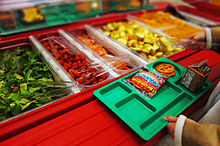
Back كافيتيريا Arabic Сталовая Byelorussian Сталоўка BE-X-OLD Столова Bulgarian ক্যাফেটেরিয়া Bengali/Bangla Cantina Catalan Kantýna Czech Cafeteria Danish Kantine German Kantino Esperanto
The examples and perspective in this article deal primarily with the United States and do not represent a worldwide view of the subject. (July 2021) |


A cafeteria, sometimes called a canteen outside the U.S. and Canada, is a type of food service location in which there is little or no waiting staff table service, whether in a restaurant or within an institution such as a large office building or school; a school dining location is also referred to as a dining hall or lunchroom (in American English).[1] Cafeterias are different from coffeehouses, although the English term came from the Spanish term cafetería, which carries the same meaning.
Instead of table service, there are food-serving counters/stalls or booths, either in a line or allowing arbitrary walking paths. Customers take the food that they desire as they walk along, placing it on a tray. In addition, there are often stations where customers order food, particularly items such as hamburgers or tacos which must be served hot and can be immediately prepared with little waiting. Alternatively, the patron is given a number and the item is brought to their table. For some food items and drinks, such as sodas, water, or the like, customers collect an empty container, pay at check-out, and fill the container after check-out. Free unlimited-second servings are often allowed under this system. For legal purposes (and the consumption patterns of customers), this system is rarely, if at all, used for alcoholic drinks in the United States.
Customers are either charged a flat rate for admission (as in a buffet) or pay at check-out for each item. Some self-service cafeterias charge by the weight of items on a patron's plate. In universities and colleges, some students pay for three meals a day by making a single large payment for the entire semester.
As cafeterias require few employees, they are often found within a larger institution, catering to the employees or clientele of that institution. For example, schools, colleges and their residence halls, department stores, hospitals, museums, places of worship, amusement parks, military bases, prisons, factories, and office buildings often have cafeterias. Although some of such institutions self-operate their cafeterias, many outsource their cafeterias to a food service management company or lease space to independent businesses to operate food service facilities. The three largest food service management companies servicing institutions are Aramark, Compass Group, and Sodexo.[2]
At one time, upscale cafeteria-style restaurants dominated the culture of the Southern United States, and to a lesser extent the Midwest. There were numerous prominent chains of them: Bickford's, Morrison's Cafeteria, Piccadilly Cafeteria, S&W Cafeteria, Apple House, Luby's, K&W, Britling, Wyatt's Cafeteria, and Blue Boar among them. Currently, two Midwestern chains still exist, Sloppy Jo's Lunchroom and Manny's, which are both located in Illinois. There were also several smaller chains, usually located in and around a single city. These institutions, except K&W, went into a decline in the 1960s with the rise of fast food and were largely finished off in the 1980s by the rise of all-you-can-eat buffets and other casual dining establishments. A few chains—particularly Luby's and Piccadilly Cafeterias (which took over the Morrison's chain in 1998)—continue to fill some of the gap left by the decline of the older chains. Some of the smaller Midwestern chains, such as MCL Cafeterias centered in Indianapolis, are still in business.
- ^ "Lunchroom". Merriam Webster. Retrieved September 12, 2019.
- ^ "Top 50 Contract Companies". Food Management Magazine. Penton. March 28, 2017. Retrieved July 4, 2017.
© MMXXIII Rich X Search. We shall prevail. All rights reserved. Rich X Search